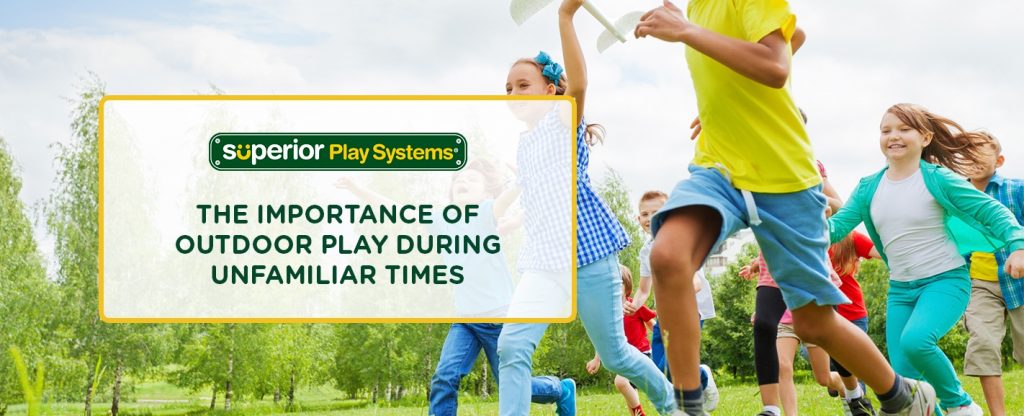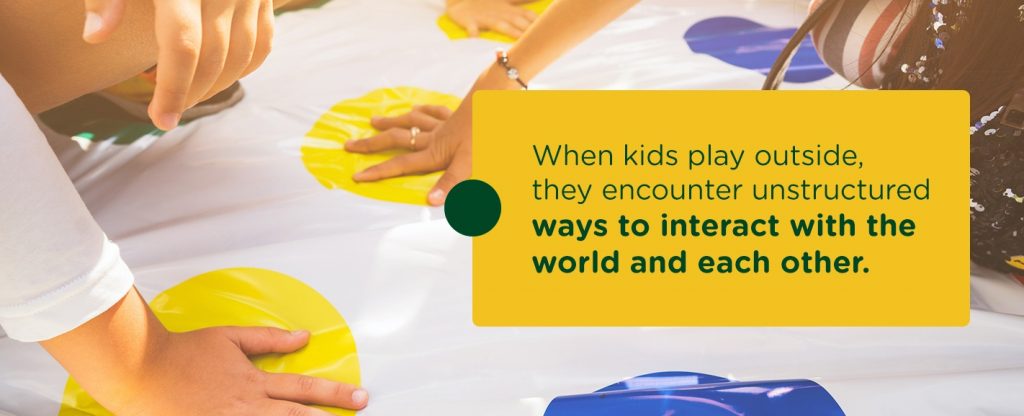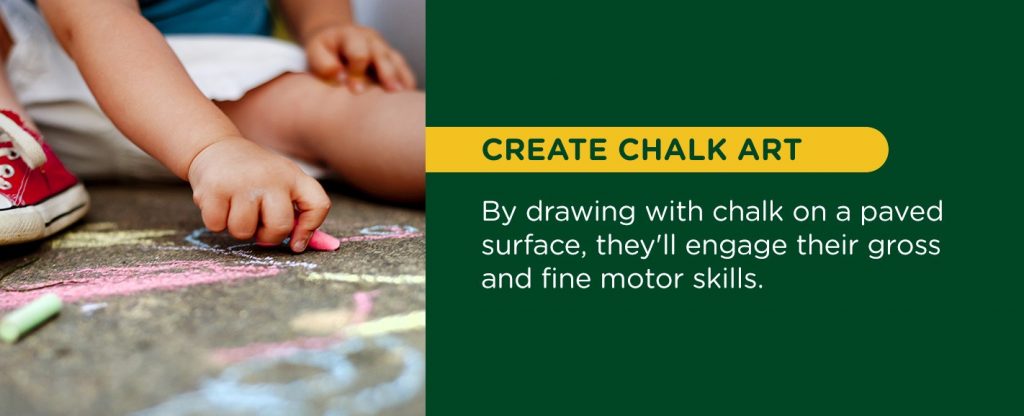The Importance of Outdoor Play

- 7 Reasons Why Outdoor Play Is Important
- Outdoor Play Ideas for Different Age Groups
- Types of Play Equipment Kids Want to Use
Today’s kids face a lot of uncertainty in their homes, schools and communities. With schools shutting down across the country due to the coronavirus outbreak, many kids’ lives have been impacted significantly. Not knowing what the future holds can lead to feelings of stress, anxiety and sadness, and being cooped up in the house can keep kids from getting the exercise they need. Fortunately, there’s a simple remedy for uncertainty and the gloomy feelings it brings — it’s called playing outside.
Children need to play outside for many reasons, from getting fresh air and sunshine to expressing their emotions. The Centers for Disease Control and Prevention (CDC) specifically recommends playing outdoors because it’s easier to maintain space between people than it is inside. They also encourage children to play outdoors for the physical and mental health benefits it brings. Even though children need to practice social distancing when they play outside, for the time being, they can still have fun and keep their spirits high. In this post, we’ll explore the importance of outdoor play for children, provide playtime ideas and look at equipment kids love to use.
7 Reasons Why Outdoor Play Is Important
There are countless benefits of outdoor play for children, which is why it’s so important kids get outside every day. For example, according to the American Heart Association, kids need at least 60 minutes of exercise every single day. Playing outside is an easy way for kids to meet their daily exercise requirements while also boosting their mental health. Here more reasons children of all ages should be encouraged to put down their tablets or laptops and head out into the sunshine.
1. Reduces Stress and Anxiety
Stress is not just something adults experience. More and more children are suffering from stress and anxiety in America. According to a WebMD survey, 72% of children showed behaviors linked to stress over 12 months, such as arguing and appearing worried. They also experienced physical symptoms related to stress, such as headaches and changes in appetite.
A simple way for kids to feel less stressed is to head outside. Being out in nature is an instant stress reliever and can make a child feel more calm and relaxed. Engaging in physical activity outdoors also helps decrease stress. When children play and get their hearts pumping, they experience a release of feel-good endorphins. They also get to blow off steam rather than keep difficult emotions bottled up inside.
Lastly, playtime reduces stress because it is a joyful experience, and it simply makes a kid feel happy. During these times of uncertainty, kids need to break away from upsetting news and information overload and reconnect with the natural world.
2. Improves Physical Fitness
According to the CDC, childhood obesity is a major concern in the United States, with nearly 14 million children affected by the problem. Playing outside combats obesity and gives kids a chance to have fun while they burn calories, build muscles, strengthen their bones and develop critical motor skills. All of this physical activity, whether it’s swinging, climbing or sliding, helps prevent serious health risks down the road.
3. Increases Vitamin D Levels
Kids need vitamin D to grow strong bones, protect their heart health and help their bodies fight infections. While certain foods, like fatty fish and fortified milk, contain some level of vitamin D, it’s usually not enough. Just 10 to 20 minutes of sunshine a day can help kids meet their daily vitamin D requirements. Sunlight is also known to create happier moods, which is another reason for kids to get outdoors.
4. Builds Cognitive and Social Skills

When kids play outside, they encounter unstructured ways to interact with the world and each other. They get to think independently, practice problem-solving skills, make up their own games and use their imaginations. They also learn positive social behaviors when they play with others outside, such as how to take turns or share playground equipment. Kids need unstructured play to practice social and cognitive skills on their own, and getting out allows them to do so.
5. Replaces Screen Time With Green Time
Most children spend an average of five to seven hours in front of a screen every day. However, it’s recommended that children spend no more than two hours a day engaged in sedentary activities like watching TV, playing video games or using a computer. Too much screen time increases the risk of obesity, sleep issues and problems like anxiety and depression.
Getting kids away from their screens and out of the house might seem like a challenge, but, in reality, electronic amusements are far less stimulating than being outside. That’s because kids experience greater sensory stimulation when they can see, smell, hear and touch the elements of nature. Once kids get out and realize how exciting and fun it is to play under the great blue sky, they’ll look forward to spending time in the sun and fresh air.
6. Improves Sleep
Children ages 6 to 12 need at least nine to 12 hours of sleep each night. Adequate sleep helps prevent issues like obesity, mental health problems and Type 2 diabetes. One way to improve sleep is to get enough exercise during the day. It also helps to reduce screen time and get regular doses of sunlight. Exposure to sunlight, particularly in the morning, helps adjust the body’s internal clock to a more natural setting, resulting in better sleep and less stress. Therefore, playing outside during sunlight hours is a great way to promote restful nights and sufficient shut-eye.
7. Boosts Academic Performance
With over 1 million children being homeschooled in the United States, parents need to remember the importance of recess. Taking a break to play outside is proven to improve memory, attention span and concentration and therefore leads to higher grades and better classroom behavior. Children should play for at least 20 minutes during the school day to enjoy the educational benefits of recess.
Outdoor Play Ideas for Different Age Groups
How can parents and educators motivate children to turn off the TV and get moving outside? We’ll share some play ideas that will get kids excited to put on their sneakers and head out the door. As you’ll see, different ages have unique needs when it comes to playing, but all children can benefit from playing outside.
Toddlers
Toddlers need even more exercise than older children because they are going through critical developmental stages and learning skills like walking, jumping and throwing. Most toddlers are naturally active, so it shouldn’t be too hard to get them to move around and have some fun outside.
Parents should aim to include a mix of structured activity with free play so toddlers can explore the world on their own. Here are some ideas:
- Imitate animals: Head to the backyard with your tot and have a blast mimicking different animal movements. For example, you might hop like a bunny or waddle like a penguin. This will encourage your child to use their muscles in new ways and build their motor skills.
- Have a scavenger hunt: Hide toys, plastic eggs or other objects around the yard or playset, but make the items easy to find. Make a list of the hidden objects with images so you can cross them off as the child finds them.
- Play classic games: Classic games like follow-the-leader, ring-around-the-rosy and hide-and-seek are fun, easy and get tiny legs moving. Play these in the yard so you have plenty of room to move around and can get doses of sunshine at the same time.
- Play a game of lawn bowling: Do you have a few empty two-liter soda bottles? You can turn them into bowling pins by adding a bit of water to each to keep them stable. Using a ball that’s heavy enough to knock the “pins” over, challenge your child to a game of lawn bowling. Award one point for each pin knocked down. Whoever has the highest score after 10 turns wins the game.
- Enjoy a bean bag ladder toss: Bring a step ladder into the backyard and label each rung with a points card. For example, you might write 20 points on an index card and tape it to the top rung, while the bottom rung might be worth 30 points. To play, toss bean bags through the rungs and see how many points you can score.
- Play make-believe: Encourage kids to play make-believe and try on different roles. Role-playing can be a great way for kids to express and explore their emotions. For example, the backyard playset might transform into a fort by the sea where pirates live. Or maybe a child would like to pretend they are a doctor or a princess on an extraordinary quest. Either way, playing make-believe is an excellent exercise for the imagination.
- Complete an obstacle course: Set up an obstacle course in the backyard to provide a thrilling challenge that’ll get kids moving. Try to have around 10 different stations with various obstacles. For example, you might have your child jump rope while they sing a short song before moving onto the next challenge. If you have a playset in the backyard, incorporate it into the obstacle course to increase the fun.
- Hunt for treasure: Consider burying a secret treasure in the backyard, and drawing up a map to help your child find it. You can also freeze colorful toys in a bucket of water. Once outside, your little one can enjoy excavating the treasures with the help of a spray bottle, spoons and some salt.
- Toss rings: Do you have some pool noodles lying around? Gather four of them to set up a ring tossing game. All you need to do is cut one of the pool noodles in half to create two goal sticks, and secure each one in the ground with garden stakes. Take the other noodles and form them into circles using duct tape. Take turns tossing the rings over the sticks and see who can score the most points.
- Put on a play: Does your child have a favorite story they’d love to act out? Or, perhaps they’d like to create a story of their own. If so, encourage them to test their acting skills and use the backyard as a spacious stage.
- Keep track: If your child has a fitness tracker, ask them how many steps they would like to complete in a day. Help them reach their goal and head outside to take laps around the yard or take the dog for a walk. They’ll have an easier time getting enough steps when they leave the house.
- Create chalk art: Help your child get creative with some colorful chalk. By drawing with chalk on a paved surface, they’ll engage their gross and fine motor skills. Let them have fun drawing whatever they wish, or you can give them a prompt. You might draw a circle and ask them to fill it in with shapes or color, for example, or challenge them to trace their shoe.

School-Age
School-age children love to play simple yard games, act out different roles and learn new skills. They enjoy structured activities just as much as using their imaginations and playing freely. Here are a few ideas to help them get started:
- Play make-believe: Encourage kids to play make-believe and try on different roles. Role-playing can be a great way for kids to express and explore their emotions. For example, the backyard playset might transform into a fort by the sea where pirates live. Or maybe a child would like to pretend they are a doctor or a princess on an extraordinary quest. Either way, playing make-believe is an excellent exercise for the imagination.
- Complete an obstacle course: Set up an obstacle course in the backyard to provide a thrilling challenge that’ll get kids moving. Try to have around 10 different stations with various obstacles. For example, you might have your child jump rope while they sing a short song before moving onto the next challenge. If you have a playset in the backyard, incorporate it into the obstacle course to increase the fun.
- Hunt for treasure: Consider burying a secret treasure in the backyard, and drawing up a map to help your child find it. You can also freeze colorful toys in a bucket of water. Once outside, your little one can enjoy excavating the treasures with the help of a spray bottle, spoons and some salt.
- Toss rings: Do you have some pool noodles lying around? Gather four of them to set up a ring tossing game. All you need to do is cut one of the pool noodles in half to create two goal sticks, and secure each one in the ground with garden stakes. Take the other noodles and form them into circles using duct tape. Take turns tossing the rings over the sticks and see who can score the most points.
- Put on a play: Does your child have a favorite story they’d love to act out? Or, perhaps they’d like to create a story of their own. If so, encourage them to test their acting skills and use the backyard as a spacious stage.
Older Children
Older kids enjoy focusing on one activity for a longer time and love competition. They also tend to think about goals and how they can reach them. So, they may wish to play games they know will help them get in shape, like basketball or volleyball. Here are some fun activities to play in the backyard with older children — you’ll likely have a great time, too:
- Play a game of lawn bowling: Do you have a few empty two-liter soda bottles? You can turn them into bowling pins by adding a bit of water to each to keep them stable. Using a ball that’s heavy enough to knock the “pins” over, challenge your child to a game of lawn bowling. Award one point for each pin knocked down. Whoever has the highest score after 10 turns wins the game.
- Enjoy a bean bag ladder toss: Bring a step ladder into the backyard and label each rung with a points card. For example, you might write 20 points on an index card and tape it to the top rung, while the bottom rung might be worth 30 points. To play, toss bean bags through the rungs and see how many points you can score.
- Keep track: If your child has a fitness tracker, ask them how many steps they would like to complete in a day. Help them reach their goal and head outside to take laps around the yard or take the dog for a walk. They’ll have an easier time getting enough steps when they leave the house.
Types of Play Equipment Kids Want to Use

Another way to encourage children to play outside and get the exercise they need is to add play equipment to the backyard. When you have the right play equipment, it’s easy for kids to have fun and lose track of time while they burn calories, build muscle and develop motor skills. Here are a few suggestions:
- Playsets: Playsets bring effortless fun to the backyard. With a playset, kids burn energy and engage their imaginations as they swing high into the air, zoom down the slide or climb up into their fort. A playset is the ideal setting for hours of playing, whether a child wants to complete an obstacle course or simply swing their stress away. At Superior Play Systems®, we offer high-quality wooden playsets designed with fun, safety and durability in mind.
- Trampolines: If you put a trampoline in the backyard, kids won’t hesitate to throw down their video controllers and get outside. Trampolines are undeniably fun, and they provide an excellent way to get exercise and build strength. Plus, there are plenty of exciting trampoline games to play, such as monkey-in-the-middle. At Superior Play Systems®, we carry only the safest trampolines in the industry.
- Basketball hoops: Playing basketball provides a complete workout and is fun for all ages. It also helps build concentration and can even be practiced alone. We offer pro-quality in-ground hoops, wall-mount hoops and accessories, so you can easily bring competitive excitement to your home for the whole family to enjoy.
Contact Superior Play Systems® for More Information
Although children face unique challenges in today’s world, kids still need to be kids. That means getting outside in the fresh air and sunshine to laugh, play and grow. At Superior Play Systems®, we’re prepared to help kids stay active and healthy, even during unfamiliar times.
To learn more about our fun play equipment and delivery services, contact us today. If you’d like to visit a local showroom, check out our locations and visit us to try it before you buy it.


